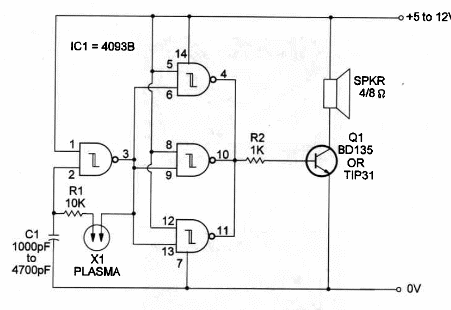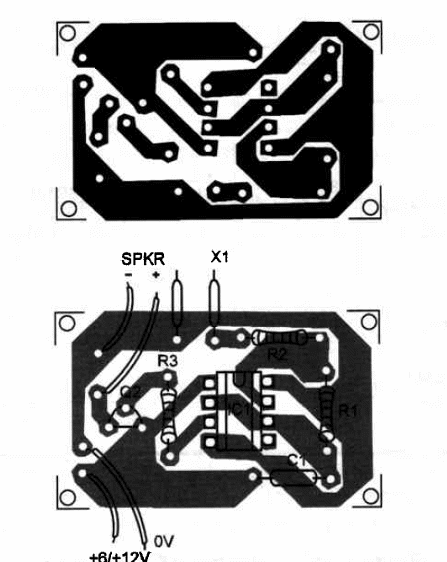A flame is a conductive medium that can be used in an uncommon feedback loop to control the frequency of an audio oscillator.
This configuration can be used as a confirmation of the conductivity of a flame.
The audio oscillator described in this project is controlled by the “fourth” matter state, the “plasma” or an ionized gas, and can be used as part of an interesting experiment in physics.
The flame can be produced by a simple match or a candle and the flickering effect will modulate the generated sound.
The circuit runs in frequencies between 1 and 500 Hz, depending on the electrodes and flame positions.
A schematic diagram of the Plasma Oscillator is shown in Figure 1.

The high input impedance of a 4093 is fundamental in this project. A flame typically has a resistance in the range of tenths of megohm.
The printed circuit board for the components positioning is shown in figure 2.

Sensor details are also given in that figure. Two wires, one placed near the other, with about 1 inch of bared length as shown in the figure, form the “plasma sensor".
The flame should involve the two bared wires at the same time to allow the feedback current to flow and the oscillator to operate.
An output stage using a piezoelectric transducer can replace the transistor and loudspeaker. With a lower current drain this configuration can be powered from four AA cells or a 9V battery.
Plasma Oscillator
IC1 - 4093B CMOS Integrated Circuit
SPKR - 4/8 ohm 4-inch loudspeaker
Q1 - BD135 or TIP31 Power NPN silicon transistor
R1 - 10,000 ohm, ¼ W, 5% resistor
R2 - 1,000 ohm, ¼ W, 5% resistor
X1 - Plasma sensor - see text
C1 - 1,000 to 4,700 pF ceramic or metal film capacitor
Ideas to Explore
To get better performance or to learn more about the circuit:
Explain why the circuit doesn’t operate using a neon or fluorescent lamp as a plasma medium.
Explain what “plasma” is.
You can alter this circuit to use it as a flame alarm.
Science applications:
- Off course, the basic idea of this project is to use it in an experiment involving plasma. Plasma is produced when an ionized gas loses electrons. The the gas converts in a “soup” of free electrons and ionized atoms.
- Use different kinds of flames, such as those produced by matches, gas, paper, etc., and compare their conductivity by the tone pitch.




